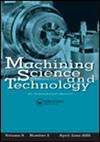微磨削工件表面温度的有限差分数值模拟与实验验证
IF 2.6
4区 工程技术
Q2 ENGINEERING, MANUFACTURING
引用次数: 0
摘要
摘要本工作的目的是表征微槽磨削过程中工件的传热和温度产生。基于有限差分法(FDM)建立了预测微磨削温度的数值模型。工件体积被划分为小的基本部分,使用热物理模型计算加工区附近和远离加工区的小部分的温度,并使用红外技术通过实验测量的温度进行验证。微槽磨削中的温度在刀具垂直插入过程中升高,当刀具在进给方向上横向时变得稳定。模拟结果表明,瞬态传热在增加的进料速率值上占主导地位,这导致进入表面的热量供应总体降低。结果还表明,由于接触长度的减少、切削力的减少、刀具-工件界面的摩擦和摩擦,刀具设计的修改对工件温度的降低有显著影响。所提出的模型能够解决微槽磨削中的瞬态问题,并且能够灵活地处理不同的边界条件。该分析将有助于温度预测和制定可能提高加工精度的温度降低策略。本文章由计算机程序翻译,如有差异,请以英文原文为准。
Finite difference numerical modeling and experimental validation of workpiece surface temperature in micro-grinding
Abstract The objective of this work is to characterize the heat transfer and temperature generation into the workpiece during micro-slot grinding. A numerical model for predicting micro-grinding temperature is established based on the finite difference method (FDM). Workpiece volume is divided into small elementary sections and temperature in small sections near and away from the machining zone is calculated using thermo-physical model as well as validated by experimentally measured temperature using infrared technique. Temperature in micro-slot grinding increases during vertical insertion of the tool and becomes stable when the tool transverse in the feed direction. Simulation results show that transient heat transfer becomes dominant on increased feed rate values that result in an overall lowering of heat supply into the surface. Results also reveal that modification in the tool design has a significant impact on the reduction of workpiece temperature due to reduced contact length, reduced cutting forces, friction, and rubbing at the tool-workpiece interface. The proposed model is capable of solving transient problems in micro-slot grinding and is flexible to deal with different boundary conditions. This analysis will help in temperature prediction and establishing temperature reduction strategies that could potentially increase machining precision.
求助全文
通过发布文献求助,成功后即可免费获取论文全文。
去求助
来源期刊

Machining Science and Technology
工程技术-材料科学:综合
CiteScore
5.70
自引率
3.70%
发文量
18
审稿时长
6 months
期刊介绍:
Machining Science and Technology publishes original scientific and technical papers and review articles on topics related to traditional and nontraditional machining processes performed on all materials—metals and advanced alloys, polymers, ceramics, composites, and biomaterials.
Topics covered include:
-machining performance of all materials, including lightweight materials-
coated and special cutting tools: design and machining performance evaluation-
predictive models for machining performance and optimization, including machining dynamics-
measurement and analysis of machined surfaces-
sustainable machining: dry, near-dry, or Minimum Quantity Lubrication (MQL) and cryogenic machining processes
precision and micro/nano machining-
design and implementation of in-process sensors for monitoring and control of machining performance-
surface integrity in machining processes, including detection and characterization of machining damage-
new and advanced abrasive machining processes: design and performance analysis-
cutting fluids and special coolants/lubricants-
nontraditional and hybrid machining processes, including EDM, ECM, laser and plasma-assisted machining, waterjet and abrasive waterjet machining
 求助内容:
求助内容: 应助结果提醒方式:
应助结果提醒方式:


